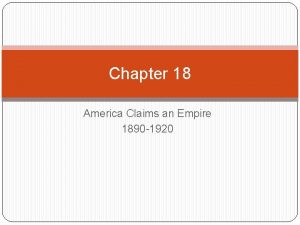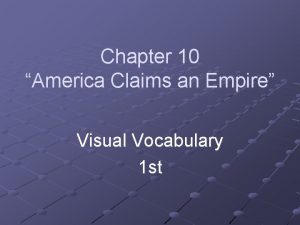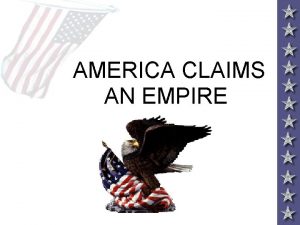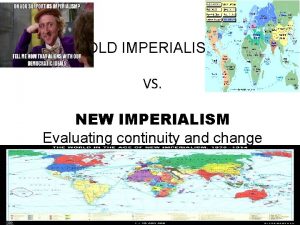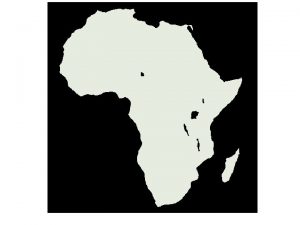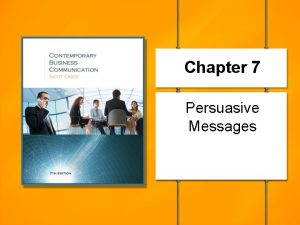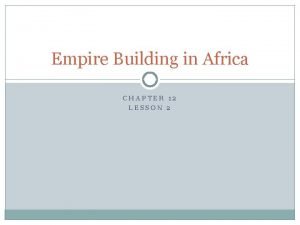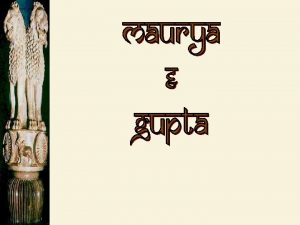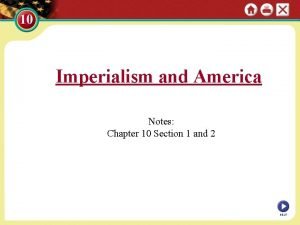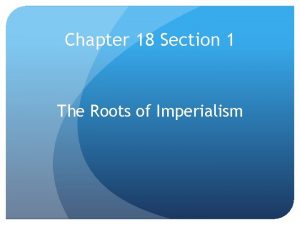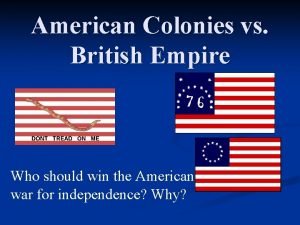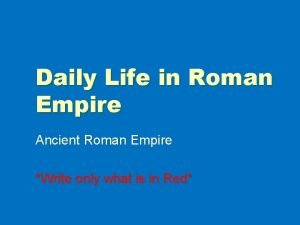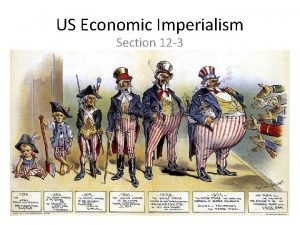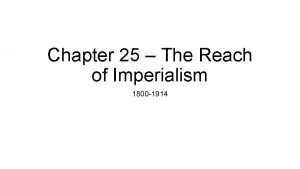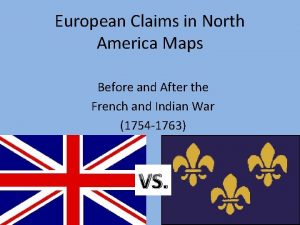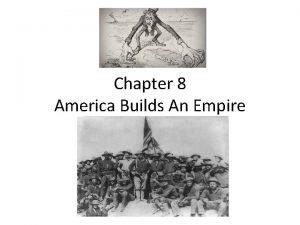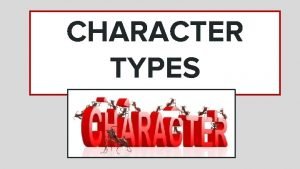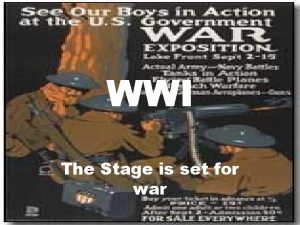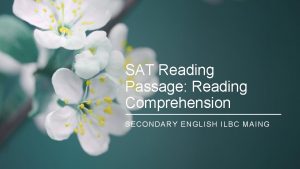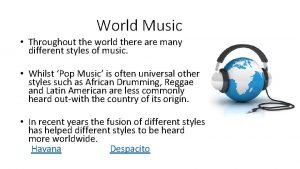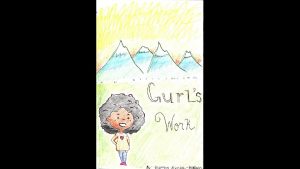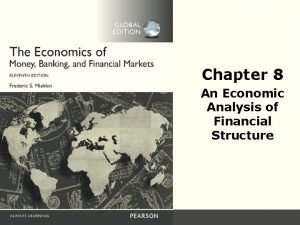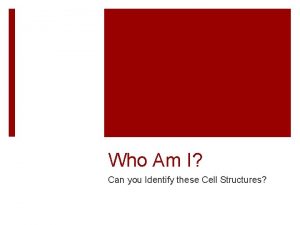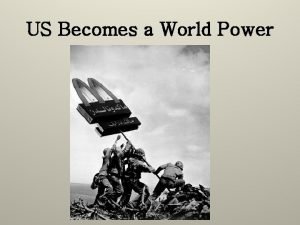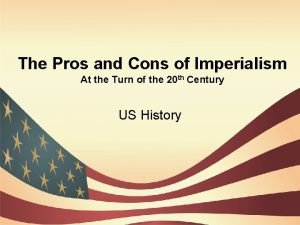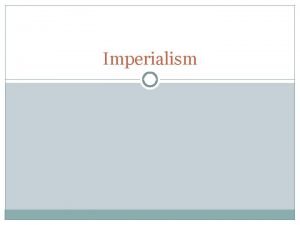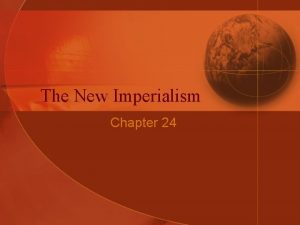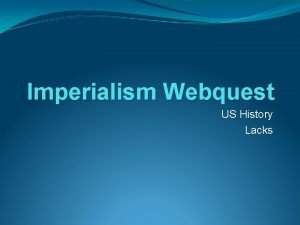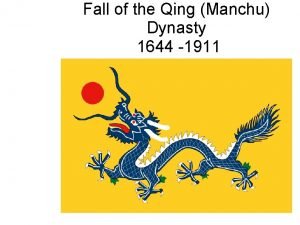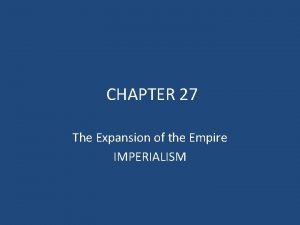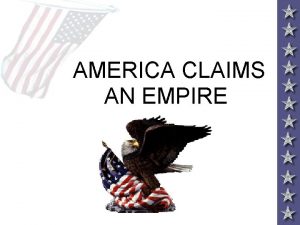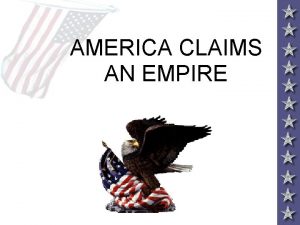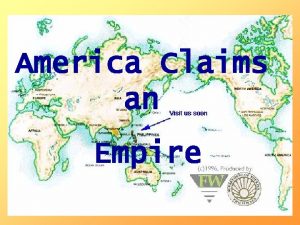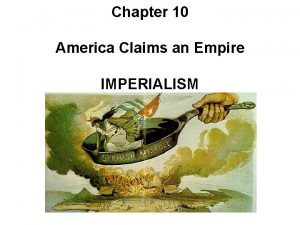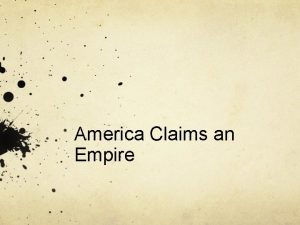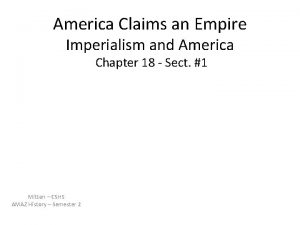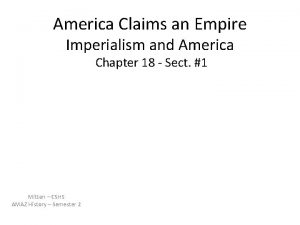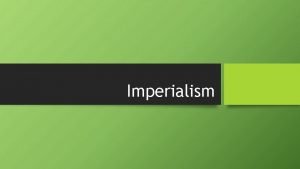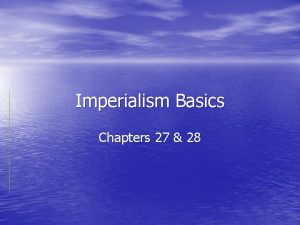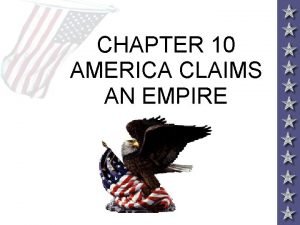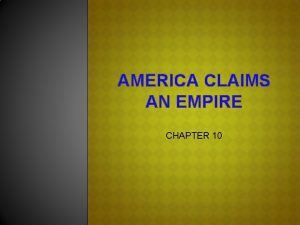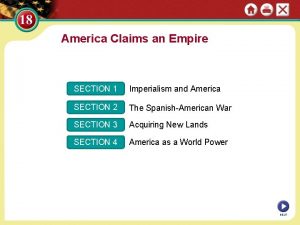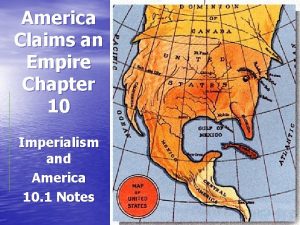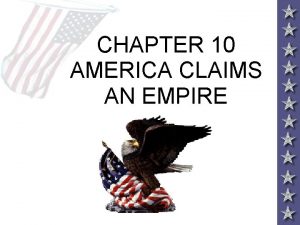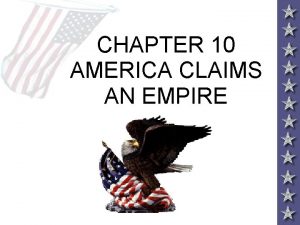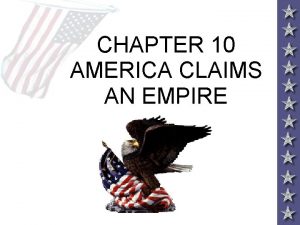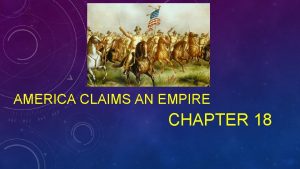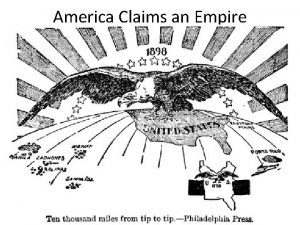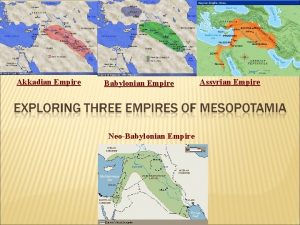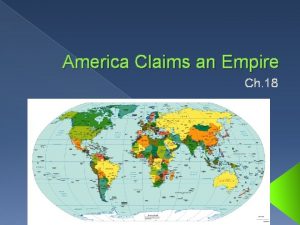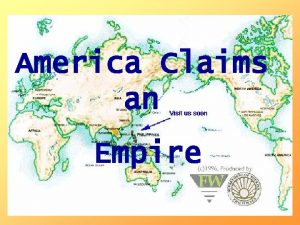AMERICA CLAIMS AN EMPIRE IMPERIALISM AND AMERICA Throughout











































- Slides: 43

AMERICA CLAIMS AN EMPIRE

IMPERIALISM AND AMERICA • Throughout the 19 th century America expanded control of the continent to the Pacific Ocean • By 1880, many American leaders felt the U. S. should join European nations and establish colonies overseas • Thus began America’s foray into Imperialism – the policy in which stronger nations extend control over weaker nations.

US Historical Motivations for IMPERIALISM? • An extension of prior expansion under Manifest Destiny • Recent European involvement in Africa and Asia

US Economic Motivations for IMPERIALISM? • New Markets. As the economy boomed, Companies needed new markets to dump excess production. • Raw Materials. Acquire essential raw material such as coal.

US Military Motivations for IMPERIALISM? • Desire for Military strength –In 1890, a naval officer named Mahan advised for a strong navy to secure our status as a leading power. An updated Navy was necessary to control sea lanes and strategic areas. • In 1890 funding approved for 3 battleships (US becomes 2 ocean navy). International navy needs coaling ports.

US Cultural Motivations for IMPERIALISM? • Belief in Cultural Superiority – a belief that Anglo-Saxons were superior and had a God given right to expand. “Social” Darwinism. • Moral Duty. According to many, Imperialism was a benevolent force that promote democracy, freedom, Christianity, and prosperity for lesser developed nations.

New Imperialism Characteristics (Summary) • • • Limited conquest through indirect Rule New Markets to continue production. Increase Military sea power God Given Right to expand Moral Responsibility to develop

Anti Imperialists Objections The Anti-Imperialist League Goal: Main goal of the Anti-Imperialist League was to fight the Mc. Kinley administration’s expansionist policies. Prominent leaders included Mark Twain, the guy with that cross of gold, and Andrew Carnegie. 8 Objections • Imperialism by its nature is incompatible with democracy. We value freedom and liberty at home. Why not extend that courtesy to them othas • Annexation would lead to immigration and wage losses • Imperialism would be too costly. Annexation would pull the US politically and militarily into conflict. Which we can’t afford • Americans are exceptional and should not engage in European style diplomacy

THE U. S. ACQUIRES ALASKA • In 1867, Secretary of State William Steward arranged for the United States to buy Alaska from the Russians for $7. 2 million • Some thought it was a silly idea and called it “Steward’s Icebox” • Time has shown how smart it was to buy Alaska for 2 cents an acre • Alaska is rich in timber, minerals and oil ska Ala

U. S. TAKES HAWAII • Hawaii had been economically important to Americans for centuries • To avoid import taxes (tariffs), sugar growers pleaded for annexation • The U. S. knew the value of the Islands – they had built a naval base at Pearl Harbor in 1887 • Led by Sanford Dole, American annexed Hawaii in 1898 and it formally became a state in 1959

Section 2 The Spanish American War

THE SPANISH AMERICAN WAR • America had long held an interest in Cuba • After Spain, a power in decline, abolished slavery in Cuba in 1886, Americans invested millions in Cuban sugar • When Cubans unsuccessfully rebelled against Spanish rule in the late 19 th century, American sympathy went out to the Cuban people Cuba is just 90 miles south of Florida

CUBA’S SECOND WAR FOR INDEPENDENCE Marti • Anti-Spain sentiment in Cuba soon erupted into a second war for independence • Led by poet Jose Marti, Cuba attempted a revolution in 1895 • Marti deliberately destroyed property, including American sugar plants, hoping to provoke American intervention

WAR FEVER ESCALATES • Newspaper publishers William Randolph Hearst (New York Journal) and Joseph Pulitzer (New York World) exaggerated Spanish atrocities and brutality in “Headline Wars” • These attempts to attract readers was called Yellow Journalism Political cartoon: Pulitzer (left) and Hearst escalating and instigating war between the U. S. and Spain

U. S. S MAINE EXPLODES Before After • Early in 1888, President Mc. Kinley ordered the U. S. S. Maine to Cuba in order to bring home American citizens in danger • On February 15, 1898 the ship blew up in the harbor of Havana • More than 260 men were killed

The Maine Explodes Unknown artist , 1898 Notice the men flying dramatically through the air

A CALL FOR INTERVENTION IN CUBA

WAR ERUPTS WITH SPAIN • There was no holding back those that wanted war with Spain • Newspapers blamed the Spanish for bombing the U. S. S. Maine (recent investigations have shown it was a fire inside the Maine) • “Remember the Maine!” became a rallying cry for U. S. intervention in Cuba • Key West and Tampa become staging areas for War.

The Teller Amendment • In April 1898 Senator Henry M. Teller (Colorado) proposed an amendment to the U. S. declaration of war against Spain which proclaimed that the United States would not establish permanent control over Cuba. . The Senate passed the amendment on April 19.

Fighting the Spanish in the PHILIPPINES • The Philippines-Admiral Dewey told to attack the Spanish fleet in the event of war. 5/1/1898 Dewey’s surprise attack defeated the Spanish fleet in Manila Bay. 8/13/1898 American troops with Filipino insurgents led by Emilio Aguinaldo capture Manila (America will regret asking Aguinaldo for help)

Fighting the Spanish in Cuba-Decisive battle at Santiago. 7/1/1898 Rough Riders (supported by 2 black regiments) fight at San Juan and Kettle Hills. 7/3/1898 the Spanish, trapped by US naval blockade and US Army, Spain surrendered. Results-Few casualties (400 to bullets; 5, 000 to malaria, typhoid fever, dysentery). War only lasted 113 days. America gained respect and prestige. Closed the North-South divide. 21

U. S. WINS; SIGNS TREATY OF PARIS • The U. S. and Spain signed an armistice on August 12, 1898, ending what Secretary of State John Hay called “a splendid little war” • The war lasted 16 weeks • Cuba was now independent but with restrictions placed by the Platt Amendment. • U. S. receives Guam and Puerto Rico • US “bought” the Philippines Treaty of Paris, 1898 for $20 million

ACQUIRING Puerto Rico-Ceded to the US as payment for war costs. Foraker Act (1900) granted Puerto Rico limited government. American citizenship granted (1917). Still a US possession (neither a state nor a territory). 23

Protecting Cuba: The Platt Amendment • Cuba- Platt Amendment (1901) US could intervene to preserve Cuban independence. US kept land for a naval base (Guantanamo Bay). Cuba had become a “protectorate” of the U. S. 24

Acquiring the Philippines • Spain offered to sell the Philippines • Mc. Kinley opted for annexation • (US Senate approved the treaty by one vote) • Filipinos wanted independence. Emilio Aguinaldo led insurrection against the US. 25

FILIPINOS REBEL Lose • Fighting lasts until 1902. 4, 234 Americans killed. 600, 000 Filipinos killed. The 3 -year war claimed and $400, 000 • US atrocities included concentration camps, torture, executions • Us improvements included construction of roads, schools, hos • Philippines not granted independence until July 4, 1946. U. S. troops fire on rebels

Section 3 From Open Door to Big Stick

China in the Late 1800’s • Situation: China is a weak in the 1890 s. European powers and the Japanese had split China into spheres of influence. • These areas have exclusive trading rights

China and the Open Door 29 • US problem: US would be left out of trade and one foreign power would dominate. • Solution: Secretary of State John Hay urged European leaders to respect Chinese rights and fair competition and to give all nations equal trading access in China.

BOXER REBELLION • European nations dominated China’s cities • Resentment arose in the form of secret societies determined to rid China of these “foreign devils” • The Boxer’s were a secret group that rioted in 1900, killing and vandalizing all things foreign • Foreign Troops were called in to put down this “Boxer Rebellion” • Gave US a greater role as mediator

American Involvement Intensifies in China • During the Boxer Rebellion, the US took on a greater role in Asian affairs by sending troops. • Later, US declares that it would be the “safeguard for the world the principle of equal and impartial trade within … the Chinese Empire. ”

Teddy Roosevelt’s Big Stick • After events in China, The US has a new president with an imperialist agenda. • His diplomacy was known as big stick, whereby the US would showcase its strength to • He acted as mediator in Russo force countries to accept US demands or -Japanese War, sent the US respect the US position. Navy to intimidate Columbia over Panama and ordered the Great White Fleet on a visible voyage to show off American naval power.

Theodore Roosevelt’s Roosevelt Corollary to the Monroe Doctrine –After Venezuela defaulted on its loan to UK, teddy stated that the United States would act like a policeman in Latin America –The object was to prevent European powers from recolonizing Latin America – “This is Our Backyard” –The United States increasingly used military force to restore stability to nations in region. 33

AMERICA AS A WORLD MEDIATOR The Nobel Peace Prize is awarded annually • A major event signaling America’s rise to power was US attempts to broker peace deals. • Roosevelt negotiated a settlement between Russia and Japan who had been at War – his successful efforts in negotiating the Treaty of Portsmouth won Roosevelt the 1906 Nobel Peace Prize

THE PANAMA CANAL • By the early 20 th century, many Americans understood the advantages of a canal through Panama, both commercially and militarily --- thanks to Mahan “The shortcut”

Taking the Canal • The French had unsuccessfully attempted the effort. • In 1903 The US agreed to buy a French holding’s. • Offer to construct and operate canal through Panama rejected by Columbia, who controlled • In 1903, US assisted Panama’s revolt against Colombia. Panama became a new republic, The US got the canal through treaty with this new republic.

BUILDING THE PANAMA CANAL 1904 -1914 Cost- $380 million Workers– Over 40, 000 (5, 600 died) Time – Construction took 10 years • Construction of the Canal stands as one of the greatest engineering feats of all-time. • The project included the eradication of yellow fever, blasting through mountains, the formation of a new lake, the construction of huge locks to adjust for changes in water elevation

This view, provided by NASA, shows the thin blue line (canal) cutting across the middle of Panama

Almost 1, 000 ships have passed through the canal, which became sole property of Panama in the year 2000

The Great White Fleet Part of the Big stick was to showcase US strength. This included the Great White Fleet, 16 battleships which peacefully circumnavigated the globe as an illustration of America's rising Power

William H. Taft’s Foreign Policy: Dollar Diplomacy Background-Federal government encouraged Wall Street bankers and other major US corporations to invest in foreign countries that were of a strategic concern to the US. The dollar would replace Roosevelt’s big stick. Dollar Diplomacy in the Caribbean-Main area of US strategic importance. US pumped money into this area to keep other countries out and to uphold the Monroe Doctrine. Policy failed when civil distress broke out in Cuba, Honduras, and the Dominican Republic. President Taft had to send in the Marines to protect American investments. 41


Woodrow Wilson’s Foreign Policy: Moral Diplomacy Background-Wilson hated Roosevelt’s big stick and Taft’s dollar diplomacy. Wilson believed that the US would be the world’s conscience. Goal of American foreign policy would be to spread democracy and promote peace. Wilson in Action-Sometimes spreading democracy required military action. Wilson sent the Marines to Haiti (1914 -1933) and the Dominican Republic (1916 -1924). (1916) Jones Act granted the Philippines territorial status and promised independence America’s Mexican Adventure- 43 American companies invested billions of dollars in Mexican oil, railroads, and mines. (1913) Mexican people rebelled. (1914) Wilson sent the Navy to capture the port of Vera Cruz. (1916) Wilson ordered General Pershing to break up Pancho Villa’s group. (1917) US withdrew because threat of war with Germany increased.
 Chapter 18 building vocabulary america claims an empire
Chapter 18 building vocabulary america claims an empire Chapter 10 america claims an empire vocabulary
Chapter 10 america claims an empire vocabulary Chapter 10 section 1 imperialism and america
Chapter 10 section 1 imperialism and america Chapter 18 building vocabulary america claims an empire
Chapter 18 building vocabulary america claims an empire The americans chapter 18
The americans chapter 18 Old imperialism vs new imperialism chart
Old imperialism vs new imperialism chart Causes of new imperialism
Causes of new imperialism Unlike routine claims, persuasive claims:
Unlike routine claims, persuasive claims: Empire building in africa worksheet answers
Empire building in africa worksheet answers Venn diagram of mauryan and gupta empires
Venn diagram of mauryan and gupta empires Chapter 10 section 1 imperialism and america
Chapter 10 section 1 imperialism and america Chapter 18 section 1 the roots of imperialism
Chapter 18 section 1 the roots of imperialism American empire vs british empire
American empire vs british empire Ancient rome recreation
Ancient rome recreation Economic imperialism in latin america
Economic imperialism in latin america Chapter 25 lesson 2 empire building in africa
Chapter 25 lesson 2 empire building in africa European claims in north america map
European claims in north america map Chapter 8 america builds an empire
Chapter 8 america builds an empire America america you mean the world to me
America america you mean the world to me North america south america europe asia
North america south america europe asia Whats an onomatopeia
Whats an onomatopeia Why is it called latin america
Why is it called latin america Happening body art
Happening body art Kinds of character in a story
Kinds of character in a story Battlefield along german and russian border
Battlefield along german and russian border Woolf uses the word we throughout the passage mainly to *
Woolf uses the word we throughout the passage mainly to * Throughout the world there are different
Throughout the world there are different 2 examples of occupational dance
2 examples of occupational dance Have been faced with
Have been faced with Throughout history people
Throughout history people Eight basic facts about financial structure
Eight basic facts about financial structure Throughout history water
Throughout history water A shot rings throughout europe
A shot rings throughout europe Im strong and stiff getting through me is tough
Im strong and stiff getting through me is tough Uniform throughout
Uniform throughout Throughout the world there are
Throughout the world there are Nutritional needs throughout the life cycle
Nutritional needs throughout the life cycle How are colonialism and imperialism different
How are colonialism and imperialism different Pros and cons of imperialism
Pros and cons of imperialism Direct control imperialism
Direct control imperialism Chapter 24 section 5 china and the new imperialism
Chapter 24 section 5 china and the new imperialism Imperialism webquest
Imperialism webquest China and imperialism
China and imperialism China and imperialism
China and imperialism
